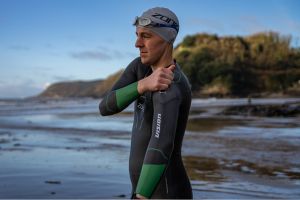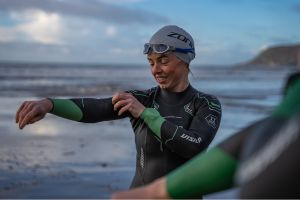Electively choosing to be cold is a bizarre concept. So, is there a secret fountain of youth found through the cold or something? Possibly. Regardless of your perception of or experience in the cold, it IS possible to build a tolerance to it and maybe even enjoy it!
Easy does it
Acclimate by definition is ‘to accustom to a new climate or environment’. This tells us that there is a process to becoming comfortable with something new. This also gives us permission to be patient with ourselves, as a new environment can be completely counter to what we’re used to. Our body already has built in mechanisms to control body temperature and conserve heat when need be, such as “goosebumps”, which reduce the amount of heat escaping the body, or shivering which generates heat to warm up the body. Our job is to train our bodies to tolerate the cold and there are a few really effective strategies you can take to slowly get comfy in the cold.
Train OUT of the water
Considering that the majority of your time is spent on land, this is where you can utilize your time to prep for the cold waters ahead. Consistency in these practices will provide the biggest returns on your time investment. Take your time! There is really no fast-tracking this process and more importantly, easing into colder temps should be done safely, with a controlled and purposeful approach. The cold is really “interesting”, in that the first days of training can be dreadful and within a week it can be the highlights of your day and incredibly energizing.
Try these simple exercises:
- Keep your thermostat down a few degrees or turn your heat off altogether. This constant exposure is subtle training that doesn’t take any extra time to commit to.
- Wear one less layer than you normally would. Skip a jacket when you normally may. Try this in short time windows at first and ease into this becoming your new attire.
- Ditch the blankets. Try sleeping with one less layer, as well; another passive way to acclimate to lower temps.
- Keep your fans on in all rooms possible. Increasing circulation of the colder air will train your body’s cold receptors to being activated.
Train IN the water… at home
Your “dryland training” was critical to build a foundation of cold-conditioning, as well as physically and mentally prepping you for the more significant task at hand - being submerged in the cold. Ambient temps tend to be a bit easier for our bodies to adapt to and tolerate, so you will again want to ease into this process with patience.
Begin your water practice in a cold tub or cold shower. It’s important to note that a cold bath or shower should be done separate from your bathing/washing itself. What tends to be easiest is to do you normal shower routine and then follow it with gradually lowering the water temps until it’s as cold as the dial goes. In the winter this will be significantly colder, of course.

Consider this - it will always be less water used to do a bath opposed to a shower. As for doing an ice bath, it’s important to clarify that there doesn’t have to be ice present in the tub to make it effective. After all, you won’t be swimming through ice… unless you are in fact training for ice swimming, in which case you have already graduated past this article. Haha! Picking up a basic thermometer for the tub is helpful to regulate the temps you’re plunging into. Keeping the temp between 55-65f will suffice, and starting on the higher end and working your way down one degree at a time each plunge will be a smooth transition. Increasing your time in the tub is more important than reaching the lowest temps possible, so gauge accordingly and set small goals of adding one minute, let’s say, each session. Take in mind, being static in a cold body of water is very different, and arguably more difficult, than swimming in cold waters. This is largely because while you’re burning calories swimming, this generates heat from your muscles, helping to regulate your core temp.
Take your training to open waters
As with the rest of your acclimation up until this point, consistency has been the driving force of your progress, and the same rings true for your cold-water swims. Use your breath as your primary focus as you stand on the shore. Internally say “inhale” as you breathe in and “exhale” as you breathe out. This singular focus will give your brain a job, one that will help you distract from the “why am I doing this?” and “ugh it’s SO cold” type thoughts. Point your mind on what it can control – your breath.
A warmup jog in your wetsuit or swim bands routine can really help create some heat before hitting the water. Choose which swim warmup works best for you and your body. Next, slowly take steps into the water, opposed to gunning it out as fast as possible. This will help to keep your heart rate down and stay laser-focused on staying internal with your breath. Keep taking steps until you’re about waste deep and at this point there’s a useful strategy you can employ, in which you splash water on your face. This helps take away that initial cold shock, because your face has the most temperature receptors in it this will signal to your brain what is about to happen. Keep taking steps forward until you’re shoulder depth and begin your freestyle nice and easy. There’s no rush. On day one, go into the swim with little gameplan beyond maintaining control of your breath and brain throughout the swim. You may notice that once you go numb, well, you’re numb and the cold because much more tolerable.
When the cold is too cold
There are thresholds to everything in life and knowing your physical limitations in the cold is vital to your safety in the open water. Always check the local water temp before suiting up, so you can first decide if it’s within your trained ability and then to mentally prep for the conditions at hand.
Signs to look out for and decide when enough is enough:
- Shivering
- Confusion
- Exhaustion or feeling very tired
- Fumbling hands or the infamous “claw”, where your fingers become useless
- Slurred speech
- Drowsiness
- Memory loss
Again, take your time in your cold-water swim progression. There’s no rush and experiencing these symptoms will most often happen when someone is trying to do more than their body is conditioned for. There’s a very peculiar phenomenon that takes place as you become more and more cold-tolerant where you start wanting to be in the cold. There’s likely some founded psychology to explain the why, but simply the hard work you put in is rewarding and brings a different kind of energy than any other type of workout. Have fun with this and be sure to share the joy with others!
For more information, visit One with the Ocean and The Swim Mechanic.






















